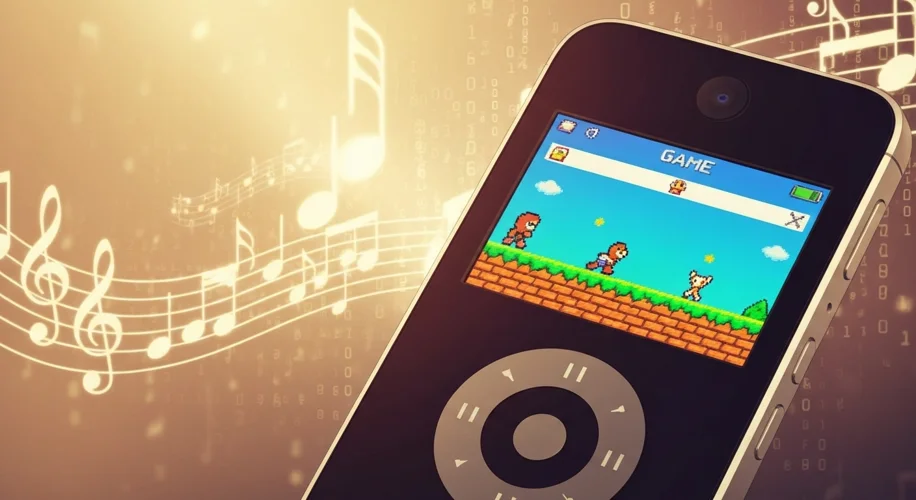The Click Wheel’s Secret History: Rediscovering Apple’s First Foray into Mobile Gaming
Before the App Store revolutionized mobile entertainment and long before the iPhone became a pocket-sized gaming console, there was the iPod. For millions, its iconic Click Wheel was the gateway to a universe of music. Yet, for a dedicated few, it was also a surprisingly capable gaming device. Simple, addictive games like Vortex, Texas Hold ‘Em, and Klondike were purchased from the iTunes Store, offering a brief diversion between playlists. When Apple phased out support for these classic titles, this entire chapter of gaming history vanished, locked behind defunct DRM and obsolete hardware. It seemed lost forever—until now.
In a monumental achievement of digital preservation, a community of dedicated archivists and developers has successfully recovered, cracked, and preserved every single game ever released for the Click Wheel iPod. This is more than just a nostalgic victory for retro gaming enthusiasts; it’s a profound case study in the fight against digital obsolescence and a fascinating look at the foundational DNA of the modern Apple ecosystem. The journey to resurrect these games sheds light on the origins of mobile gaming and provides a direct lineage from the simple scroll-and-click interface to the sophisticated spatial computing experiences promised by the latest Apple Vision Pro news. This effort reminds us that within today’s complex world of iOS updates news and interconnected devices, the seeds were sown in the humble, single-purpose focus of the original iPod.
An Overview of a Forgotten Platform: The iPod as a Gaming Device
While the original iPods were purely music players, Apple began experimenting with interactive entertainment with the launch of the 5th Generation iPod (often called the “iPod Video”) in 2005. This device, along with later models like the iPod Classic, featured a color screen and the processing power necessary to run basic games. This marked a pivotal, albeit quiet, moment in Apple’s history, setting the stage for its future dominance in the mobile application space.
The Dawn of the iTunes Game Store
Initially, iPods came with a few pre-installed games like Brick and Solitaire. However, in 2006, Apple opened a new section in the iTunes Store dedicated to games designed specifically for the Click Wheel interface. For a typical price of $4.99, users could purchase and download titles from established developers like EA, Namco, and Sega. The library grew to include nearly 50 titles, ranging from simple puzzlers to surprisingly complex adaptations of popular franchises.
- Vortex: An innovative game reminiscent of Breakout, where players used the Click Wheel to move a paddle around a 360-degree circular well.
- Texas Hold ‘Em: A polished poker simulation that showcased the potential for more strategic, slower-paced gameplay.
- Sonic the Hedgehog: A port of the classic Sega game, demonstrating that action-platformers were viable on the hardware.
- Pac-Man: A faithful adaptation of the arcade legend, proving the timeless appeal of simple, well-executed mechanics.
These games were not technological marvels compared to the Sony PSP or Nintendo DS. Their significance lay in their integration. They were purchased through the same software used to manage music, synced to the same device, and played on the go. This seamless experience was a precursor to the frictionless ecosystem Apple would later perfect with the iPhone and iPad. The latest iPad news often focuses on powerful new creative tools, but the core principle of a unified hardware and software experience can be traced back to these early experiments.
The Technical Hurdles: DRM and Obsolescence
The magic of the iPod game store was also its eventual downfall. The games were sold as .ipg files, encrypted with Apple’s FairPlay DRM. This digital rights management system tied each game purchase to a specific user’s iTunes account. When Apple discontinued the iPod Classic and subsequently removed the game section from iTunes, the official method for acquiring or re-downloading these titles disappeared. Even for those who had backups, activating them on a new or restored iPod became impossible. This created a “digital dark age” for this unique gaming library, a common pitfall in closed ecosystems that prioritizes control and security, a theme still relevant in today’s discussions around iOS security news and Apple privacy news.
The Digital Excavation: A Community’s Quest for Preservation

The complete recovery of the iPod’s game library is a story of persistence, technical ingenuity, and collaborative effort. It wasn’t a corporate-led initiative but a grassroots movement by a group calling themselves the “iPod Game Preservationists.” Their work serves as a masterclass in digital archaeology, overcoming technical and logistical challenges that had rendered these games unplayable for over a decade.
Reverse-Engineering FairPlay DRM
The single greatest obstacle was the FairPlay DRM. To preserve the games, the encryption had to be broken. This required a deep, technical dive into the iPod’s firmware and the authentication process it used to verify game ownership. The preservationists analyzed how a legitimately purchased game “authenticates” with the device. By meticulously reverse-engineering this handshake process, they were able to develop a tool that could strip the DRM from the .ipg files without altering the core game code. This process is painstaking, requiring a sophisticated understanding of cryptography and low-level software engineering.
This effort is a real-world example of the ongoing tension between content protection and long-term preservation. The same security measures that protect developers’ intellectual property can become an insurmountable barrier to accessing cultural artifacts once a platform is no longer supported. It highlights the importance of “right to repair” and software ownership debates that continue to surface in modern Apple ecosystem news.
Sourcing and Archiving Every Title
Cracking the DRM was only half the battle. The team then had to track down a copy of every single game ever released. Since the games could no longer be purchased, this meant scouring the internet for individuals who had purchased them back in the day and still had the original files on old hard drives or backups. This became a global crowdsourcing effort.
They created checklists and coordinated through forums and chat servers, slowly but surely acquiring the full set of nearly 50 titles. Each submitted file had to be verified for integrity to ensure it was an original, unmodified copy from the iTunes Store. This meticulous archival process ensured that the final collection was a perfect, untampered representation of the iPod’s gaming history, from the well-known hits to the most obscure titles. This community-driven archival is a powerful counterpoint to the top-down content delivery of modern services like Apple TV, where content availability is dictated by licensing deals, as often discussed in Apple TV marketing news.
Implications and Insights: The iPod’s Enduring Legacy
The successful preservation of these games is more than a technical feat; it provides critical insights into Apple’s strategic evolution and the broader landscape of digital media. It connects the dots between the single-function iPod Mini and the multi-sensory Apple Vision Pro, showing a clear, iterative path of innovation in user interface and digital content delivery.
The Blueprint for the App Store and Apple’s Ecosystem
The iPod’s game store was a trial run for the App Store. It established the core principles: a centralized, curated marketplace; simple, one-click purchasing; and seamless synchronization to a mobile device. While the Click Wheel was a limited input method, it forced developers to create intuitive, accessible experiences—a design philosophy that remains central to Apple’s success. The latest iPod Touch news before its discontinuation showed a device that was essentially an iPhone without the phone, a pure App Store machine whose lineage began here.

This early ecosystem thinking extends to accessories. The iPod created a multi-billion dollar accessory market for cases, docks, and speakers. Today, that has evolved into a sophisticated lineup including AirPods news, with products like the AirPods Pro and AirPods Max offering deep software integration, and the Apple Pencil news, which transforms the iPad into a professional creative tool. The recent rumors of an Apple Pencil Vision Pro or a Vision Pro wand suggest this philosophy of tightly integrated hardware and software accessories continues to drive Apple’s strategy, a far cry from the simple 30-pin connector of the iPod Classic.
Lessons in Digital Preservation and Platform Longevity
This project serves as a stark reminder of the fragility of digital media. In an era of streaming services and cloud-based content, true ownership is rare. When a company decides to shut down a server or discontinue a product line, entire libraries of software and art can be lost. This has significant implications for everything from video games to digital art created on an iPad, a popular subject in iPad vision board news.
The iPod game saga is a powerful argument for the importance of community-led preservation efforts. Without this dedicated group, a unique and important part of Apple’s and gaming’s history would be gone forever. It underscores the need for legal frameworks and technical tools that allow for the legal archiving of software for historical and cultural purposes, especially when it is no longer commercially available. This is a critical consideration as we move into even more complex digital ecosystems, where devices like the HomePod and HomePod mini rely entirely on cloud services to function.
Recommendations and Final Considerations
For those interested in experiencing this slice of retro gaming history, the path is now open, though it requires some technical know-how. This preservation effort also offers broader lessons for consumers and technologists alike in the modern Apple ecosystem.
For the Retro Gaming Enthusiast
Playing these preserved games isn’t as simple as downloading an app. It typically involves acquiring a compatible iPod model (like a 5th Gen iPod Video or a final-generation iPod Classic) and using community-developed custom firmware, such as Rockbox, which allows for the installation of unsigned applications. The preserved, DRM-free game files can then be loaded onto the device. This process of “modding” is a hobby in itself and offers a deep appreciation for the hardware’s original design and limitations. It’s a hands-on way to engage with the history that led to today’s seamless user experience, where a simple “Hey Siri” command can launch any app, a topic often covered in Siri news.
Best Practices for a Digital Future
The story of the lost iPod games offers several key takeaways for navigating our increasingly digital world:
- Advocate for Ownership: Be aware of the difference between licensing content and owning it. Support platforms and developers that offer DRM-free options where possible.
- The Value of Backups: While it wouldn’t have solved the DRM issue here, maintaining personal, offline backups of important digital purchases is a critical practice.
- Support Preservation Projects: Acknowledge and support the work of digital archivists. Organizations like the Internet Archive play a crucial role in safeguarding our collective digital heritage.
This event is a potent reminder that today’s cutting-edge technology, from the health sensors in the Apple Watch news that fuel Apple health news to the advanced tracking of an AirTag, will one day be obsolete. Ensuring our digital culture survives requires a proactive and community-focused approach to preservation.
Conclusion: More Than Just a Game
The resurrection of the iPod’s gaming library is a landmark achievement that resonates far beyond the retro gaming community. It’s a celebration of a forgotten era of innovation, a testament to the power of dedicated communities, and a cautionary tale about the impermanence of digital media. This project not only brings back beloved games like Vortex but also preserves the crucial first chapter in Apple’s journey toward mobile dominance. It provides a tangible link from the humble Click Wheel to the ambitious frontiers of Apple AR news and spatial computing. As we look forward to an increasingly interconnected and software-driven future, the story of the lost iPod games is a vital reminder to honor and preserve the digital past that brought us here, paving the way for every piece of iPod revival news and nostalgic tech story to come.











